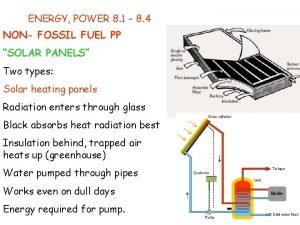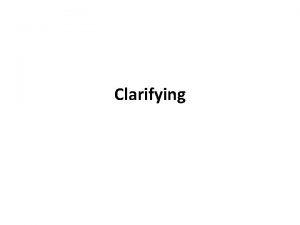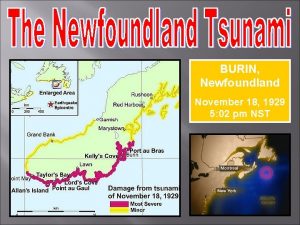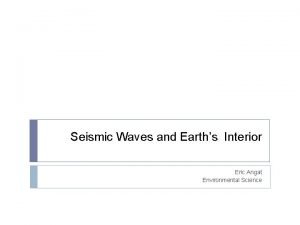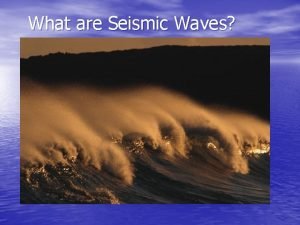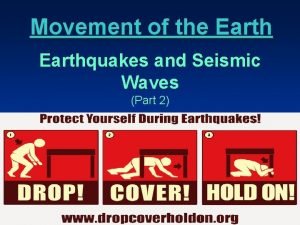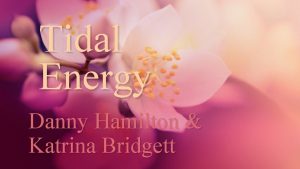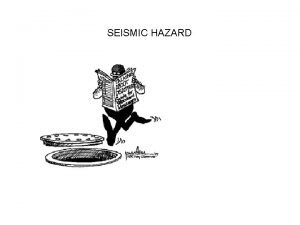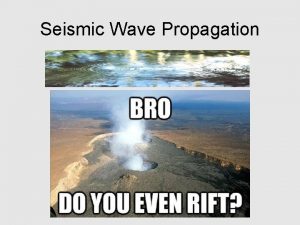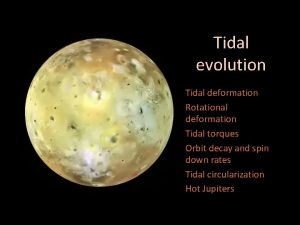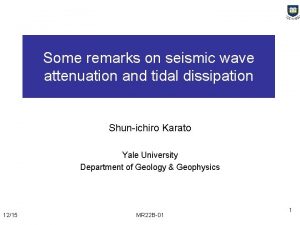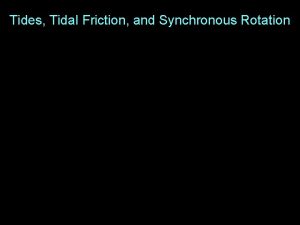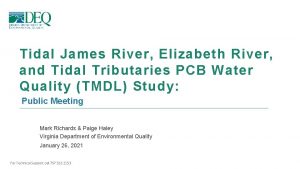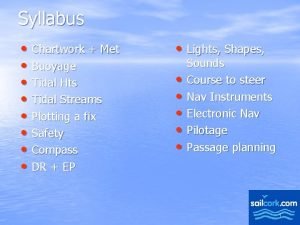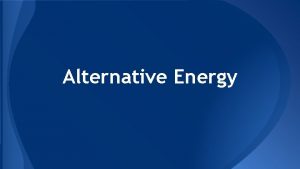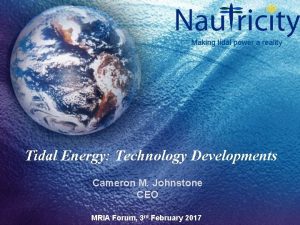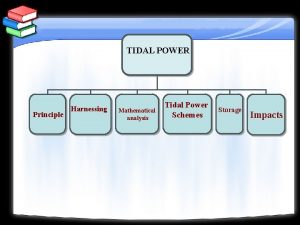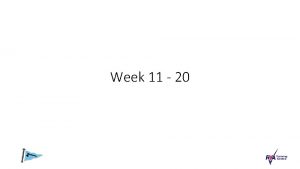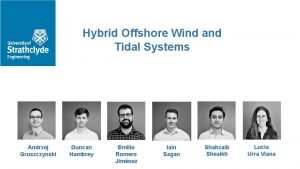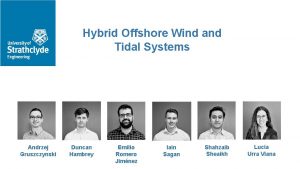Offshore Seismic and the Regulatory Tidal Wave Shawn

















- Slides: 17

Offshore Seismic and the Regulatory Tidal Wave Shawn L. Rice Board of Directors, IAGC NOIA Annual Meeting April 20, 2016 shawn. rice@iongeo. com

5 Year Lease Plan March 15 th, 5 -Year Plan Released (2017 – 2022) – – Excludes Leasing Offshore Atlantic Limited Leasing Offshore Alaska (3 Potential Sales) Western/Central Gulf of Mexico (10 Potential Sales) BOEM is Holding Public Hearings & Accepting Comments Geophysical Industry Pursuing Atlantic Permits – 4 Member Companies have Permits Pending – 2 Years and Waiting • Statue Requires a 45 Day Timeline Once Applications are Received 2

Atlantic IHAs NOIA Joined IAGC & API in Sending a Letter and Meeting with NOAA/BOEM – Concerns Over Delays and Potential Precedent for GOM – Use of Non-publically Available Data NMFS Continues Delays – – Duke University Density Models Exclusion Zones Seasonal Restrictions Ongoing Requests from NMFS to Applicants 3

Examples of Excluded Areas Expanding Ideas of “Critical Habitat” – To include current and “potential” habitat – To anticipate climate change Essential Fish Habitats – Originally designed as a protection against fishing Marine Sanctuaries – Protections expanded to include sound – Commercial fish species – Increased focus on marine invertebrates 4

Regulatory Trends The Challenges: • Increasing the number of species of concern • Expanding protected areas on land sea • Increasing focus on other effects; masking, stress • Additional mitigation requirements (e. g. PAM, certification) • Possibly restriction on “duplicative surveys” • Sound source verification measurements • Caps on anthropogenic sound More Burdensome Compliance The Advancements: • Funding of national data and research needs • Alternative sound source technologies (e. g. marine vibrators, passive seismic) • Quieting technologies (e. g. bubble curtains) 5

Additional On-board Mitigations • PSO and PAM mitigation are not “ 100% effective”. – Industry is actively involved in efforts to improve PSO and PAM training, technology standards and operator certification. • The industry is also sponsoring research to explore additional mitigation tools like infrared cameras, active sonar, unmanned vehicles – These technologies, if found to have added benefit, also represent added cost and added demands on vessel ops. • Good News: due to industry investment, PAM monitoring has increased regulator comfort with night operations. 6

Caps on Manmade Sound • As the public and regulators become more aware of the expanding production of sound from human marine activities, emphasis is shifting from managing single types of sound (sonar, seismic, shipping) • Concepts of acoustic ecology and sound zoning from urban and recreational land areas are being transferred to thinking about marine noise management, with or without legal basis. » EU “Good Environmental Status” guidelines from the marine environment include noise measurements and metrics (Descriptor 11) » NOAA NMFS maintains a Cetaceans and Sound website where marine acoustic data are archived and mapped. There are no laws for managing sound as a totality, but regulators are increasingly invoking cumulative effects arguments. http: //cetsound. noaa. gov/sound_data 7

Research and Data Funding Attempts to regulate seismic have revealed shortfalls in the regulator’s marine environmental data – E. g. , knowledge of abundance and distribution of non-commercial species is typically insufficient to assess potential risk from allowing activities The actual effects of noise (versus speculated effects) remain uncertain – Regulators may attempt to fill those gaps by encouraging directed research by industry applicants: recent examples include Brazil and US Gulf of Mexico. Regulators may also seek to have the E&P industry fund their general needs – E. g. , stranding programs, acoustic data libraries, and monitoring data services. Challenges – The desire to obtain permits by making concessions, – Other relevant stakeholders (fisheries, shipping, renewable energy) may not be assessed equitably with E&P industry, – Control of quality & independence of the work. 8

Good News: Some Dying Myths • • Marine seismic remains a poorly understood technology and commercial enterprise. “Duplicative Surveys” – While regulators may try to limit the number of overlapping surveys (e. g. multiple 2 D surveys) there is increasing understanding that different companies provide different proprietary work products that are not “duplicative”. • Vessel Spacing – Initially applied in the Chukchi Sea as a “walrus corridor”, – BUT--Spreading multiple sources may actually increase durations of exposure, more important than additive loudness. • Least Practicable Source Level – Operators who are prepared to defend their array designs are more likely to prevail with regulators seeking a “quieter” source. INDUSTRY MUST BE PREPARED TO PUSH BACK! 10

Marine Compliance Common Mitigation & Monitoring: • • • Pre-survey planning Geographic and seasonal restrictions Visual observations Soft-start or ramp-up Shut down or delay of activation of sources for animals within exclusion zone • Requirements or restrictions during nighttime / low visibility 11

Gulf of Mexico Settlement Original Settlement (June 2013 – Dec 2015) – Plaintiffs Challenged Lack of Regulations in GOM February 10 th, Settlement Agreement Extended through September 21 st 2017 with Added Provisions: – 5 km Buffer Zone of Areas of Concern – Jan 1 through Apr 30 Seasonal Restriction – Incentivizes the use of “Noise Reduction Technology” – Extension of Permit Terms when Affected by Seasonal Restriction 12

GOM Regulation Timeline • NEPA - Environmental Impact Statement – Draft Provided for Comment in Summer 2016 (est) • MMPA - Incidental Take Regulation – BOEM will Submit to NMFS in May 2016 (est) • ESA - Consultation/Biological Opinion – IAGC Requesting Applicant Status to Review Draft Geophysical Industry Working to Ensure Nonscientific Settlement Provisions & Atlantic Delays are not Applied in GOM Regulation Note: Public comment and final EIS/ITR through record of decision due by September 2017 (based on settlement agreement) 13

Gulf of Mexico Monitoring • Incidental Take Regulation (Monitoring & Mitigation) – IAGC is Working with BOEM to Ensure Monitoring Requirements are Limited to Specific Permitted Activities – Statute Only Allows the Agency to Require Specified Activities be Mitigated – IAGC is Seeking Flexibility for Members so Advances in Technology can be Implemented for Mitigation 14

NMFS Acoustic Guidance – Current guidance (created in 1995) is out of date and has been for over a decade – NMFS has produced and failed to adopt THREE prior revisions • 2007, 2013 and July 2015 • All prior drafts were externally peer reviewed and open for public review for 30 days or longer. – Significant Revisions from Prior Drafts were issued mid-March 2016 • No external peer review • 14 Day Comment Period – Inadequate – Latest Revisions Pose Major Problems for G&G • Produces a Major Increase in the size of Exclusion Zones over July 2015 draft (A comparable increase in the Number of Level A Takes) – IAGC/NOIA/API/AOGA Has Submitted Comments Opposing the Brevity of the Comment Period and the Reliance on Non-Peer Reviewed Information – IAGC is Engaging Congress to Oppose the Revisions as Improperly Prepared and Inadequately Reviewed 15

No evidence of biological consequences from behavioral response to seismic surveys! Ø US Gulf of Mexico ü ~50 years of E&P activities ü sperm whale population stable Ø West Coast Australia ü ~35 years of E&P activities ü humpback whale population increasing Ø Chukchi Sea and Beaufort Sea ü 30 years of E&P activities ü bowhead whale population increasing 16

In Summary Continued Attention on Atlantic: • Unacceptable Delays Cannot be Duplicated in GOM • NMFS Must Make Permitting Decisions • IAGC Urges Continued Support from NOIA in Applying Pressure for G&G Permit Decisions Gulf of Mexico Regulatory Focus: • • Draft EIS, ITR, Monitoring Plan, and ESA Consultation Manage Regulatory Impacts on G&G Activities Engage Congress Throughout the Process Work with Stakeholder Industries to Support Offshore 17

18
 Wave and tidal power
Wave and tidal power Tidal stream generator
Tidal stream generator Kerosene meigle
Kerosene meigle Which seismic wave refracts and cannot penetrate the core
Which seismic wave refracts and cannot penetrate the core Seismic wave types
Seismic wave types What are the three types of seismic waves
What are the three types of seismic waves Is a seismic wave mechanical or electromagnetic
Is a seismic wave mechanical or electromagnetic Seismic waves
Seismic waves Seismic wave cracker
Seismic wave cracker Difference between full wave and half wave rectifier
Difference between full wave and half wave rectifier Transverse and longitudinal waves both *
Transverse and longitudinal waves both * Center tapped transformer full wave rectifier
Center tapped transformer full wave rectifier Determining the arrival times between p-wave and s-wave
Determining the arrival times between p-wave and s-wave Mechanical and electromagnetic waves
Mechanical and electromagnetic waves Energy that travels through
Energy that travels through Velocity frequency wavelength triangle
Velocity frequency wavelength triangle Single basin and double basin tidal power plant
Single basin and double basin tidal power plant Advantages and disadvantages of tidal energy
Advantages and disadvantages of tidal energy
